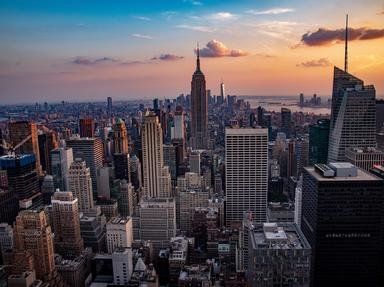Quiz Answer Key and Fun Facts
1. In New York City, 1940 to 1959, I grew up in an apartment at the corner of 110th St. and Riverside Drive, generally called the Upper West Side or UWS. I thought of this park as my backyard - although it was in front. What was it called?
2. About a block east of Broadway, on 110th St., was arguably the largest cathedral in the world, and the reason for 110th St. to change its name to Cathedral Parkway. Which Episcopal cathedral was this?
3. Two well-known museums are on 5th Avenue, about two blocks from each other. What are they called?
4. Cornell University is only about seven blocks from where we lived (i.e., the corner of 110th St. and Riverside Drive).
5. There were some great places to ice skate in the winter in NYC in the 1940s-1950s. Which of these was NOT one of them?
6. Many New Yorkers seldom visit the tourist attractions around the city unless they have guests who want to see them. I believe we thought these sites would always be there if we wanted them. Sadly, the Twin Towers were destroyed in 2001. The next tallest building in the city at the time was what?
7. A rare treat in the 1950s was to go to the Brooklyn Paramount to see the new type of music being performed - rock and roll. What New York disc jockey, nicknamed "Moondog", was a big promoter of rock and 'doowop' on station WINS?
8. Before J.F.K. Airport had this name, what was it called?
9. There are many embassies and consulates in New York, as there are in Washington, D.C. This is necessary because which organization meets here in a tall building facing the East River?
10. The Staten Island ferry used to cost only a nickel in the 1940s-1950s.
11. A very special trip was to a famous NYC theater, especially around Christmas when the entire area was decorated beautifully. The theater featured an orchestra that came up on an elevator platform among sparkling lights and, on stage, the famous group of high-stepping girls called what?
12. You don't always want to ask a New Yorker for directions in the city. What famous answer will you get if you ask how to get to Carnegie Hall?
13. In the summer of 1957, I studied at the Art Students' League downtown on 57th St. It was a great experience for me as we had live models and some very fine artists. Most of the young men I met were all fired up about going to Cuba and helping overthrow the dictator there. What was his name?
14. Lower Manhattan was a great place to shop for specialty foods, and often my dad took me along to The Fulton Fish Market and Callanan's. Fresh fish, pickled herring and real cheese, as well as real black pumpernickel, were available and the smells were enough to make one salivate. What other famous site is in roughly the same area of the city?
15. The Metropolitan Museum is in charge of this outpost, which is much further north and at one of the last stops on the subway in Manhattan. This is a lovely fortress of stone that contains a museum, park, open air walks, a view of the Hudson River and New Jersey. What is its name?
16. New York has a great subway system. Which of these was NOT part of it in the 1950s?
17. High up in the east Bronx was a terrific place to visit in the 1950s. Even if you haven't been there, you've most likely heard of this home to many animals.
18. The only Broadway show I ever saw featured one of my favorite entertainers. Who was that versatile man in "Mr. Wonderful"?
19. In grammar school, most kids attended a P.S.#. Mine were P.S. 165 and then P.S. 54. What does the P.S. stand for in NYC?
20. The big three baseball teams in New York in the '50s were The Yankees, The Giants and The Dodgers. Yankee Stadium was home to the first, The Polo Grounds to the second, and which to the Dodgers?
21. This island's name is heard on many cop shows that take place in New York. Which of these was the world's largest penal colony?
22. City Island was once a major shipping area and built some of the America's Cup yachts.
23. My dad belonged to a rowing club on the Harlem River in the 1930s and 1940s. It used the then alternate name of New York, which was what?
24. Governor's Island is the alternate residence for the governor of New York State.
25. The Statue of Liberty's home was called Bedloe's Island in the '40s and '50s.
Source: Author
alexis722
This quiz was reviewed by FunTrivia editor
Pagiedamon before going online.
Any errors found in FunTrivia content are routinely corrected through our feedback system.
